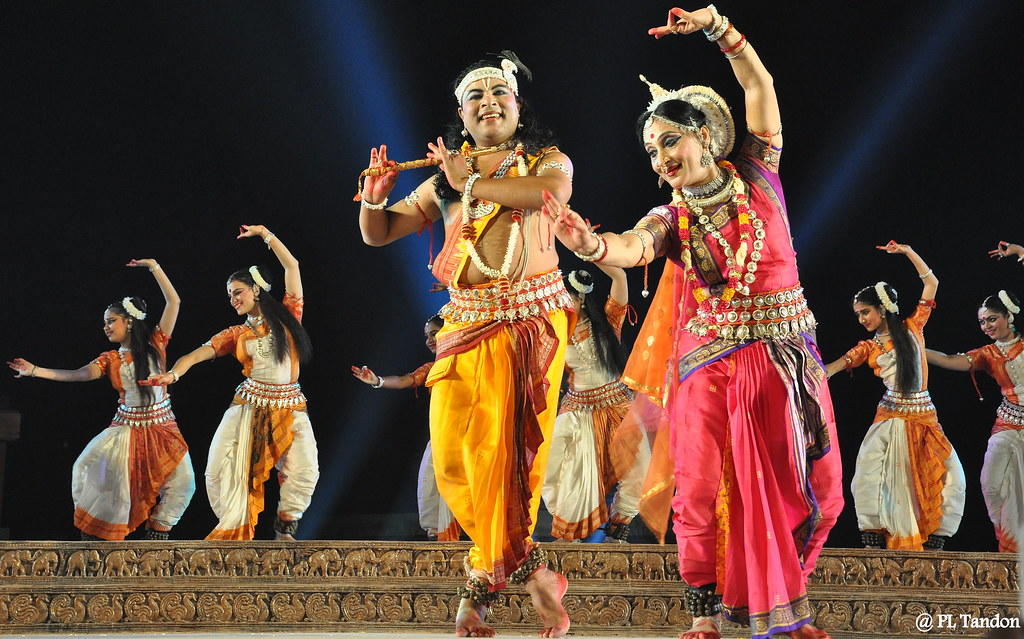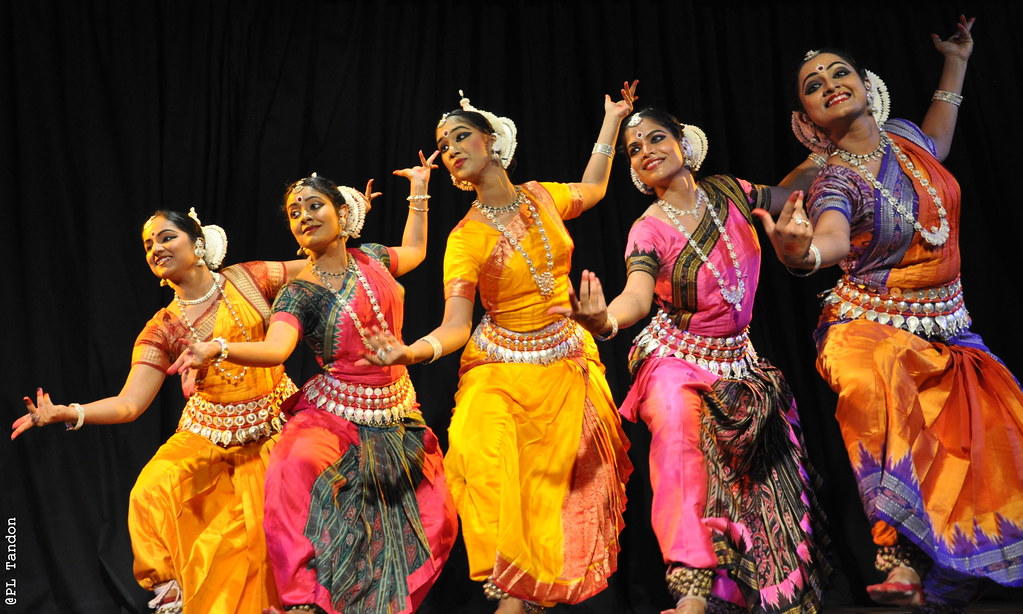Odissi, one of India's most famous classical dance styles, has its roots in the Hindu temples of the state of Odisha, which is located on the country's eastern coast. Its theoretical foundations can be found in the ancient Sanskrit Hindu literature "Natya Shastra," which discusses performing arts. Odisha Hindu temples and other historically significant locations connected to Buddhism, Jainism, and Hinduism are the source of the age-old Odissi tradition, the sculptures of which embellish the dancing postures of this art form.
Odissi's performance repertoire includes invocation, nrita, nritya, natya, and moksha.
It is an illustrated story of legendary and religious stories, devotional poems, and spiritual ideas emoted by dancers with great body movements, expressions, impressive gestures, and sign language. Themes from Vaishnavism as well as those connected to Hindu gods and goddesses like Shiva, Surya, and Shakti are used in the Odissi dance style.
Learn about the history of Bharatnatyam.

Learn about the evolution of the Kathak dance style.

History of Odissi Dance Form
Elegant body language, expressive facial emotions, vivid costumes, and cosmetics are characteristics of Odissi dance. The dancer depicts different characters, tells stories, and emotes with complex hand gestures. The fluidity and expressiveness of the dance style are enhanced by the adaptable footwork that harmonizes with the beat and melody.
Originally, it was only women who performed Odissi, telling tales in the form of dance dramas to honor Lord Vishnu. Over the course of countless ups and downs, this art form moved from temples to dance institutes run by devoted enthusiasts, instructors, and practitioners who prepared the next generation to carry on this art form's legacy, and ultimately to the international scene as a symbol of India's rich cultural legacy.
According to legend, Lord Jagannatha cherished hearing the beautiful lyrics from Jaidev's Gita Govindam. To satisfy him, these lyrics were chanted in front of him at the Jagannatha Temple in Puri. The Odissi dance's musical foundation was thus derived from the same verses. The Odissi dance dramas also benefited greatly from the rich source material that was Odisha's classical literature.
Become an Odissi dancer with dance classes in Delhi, at-home or online classes taken by 1000s of passionate dance teachers from all over New Delhi
The origins of Odissi dance may be traced back to the temples of Odisha during the second century BCE, making it one of the oldest classical dance styles still in existence in the nation. Similar to all other Indian classical dance styles, Odissi performances were a component of temple adoration. The vibrant sculptures of different dancing postures etched on the walls of Konark's temples bear witness to this.
Odissi's history is identical to that of other ancient Indian dance genres. It is thought that the old dance forms left the heavenly orb behind. The Tandav Nritya by Lord Shiva and the dance done by Lord Vishnu in his Mohini Avatar greatly influenced the dancers' postures, expressions, and dance routines. Indian traditional dancers have primarily been trained in temples and royal courtrooms. This also applies to Odissi. This assertion is supported by archeological evidence discovered in the Manchapuri caves at Udayagiri, Hathigumpha, which contains inscriptions dating back to the first or second century BCE, as well as in the temples of Bhubaneswar, Konark, and Puri.
Learn about the origins of the Kathakali dance style.
Odissi was performed in this era by female Maharis, temple dancers who devoted their lives to serving the gods. They performed Odissi as a means of expressing their devotion and were an essential component of the temple rites. The repertoire, methods, and traditions of the old Odissi were preserved by the Maharis. They ensured the survival of the dance form by passing down the wisdom and techniques of the Odissi through the centuries. Their distinct style, which was defined by sensuality, elegance, and fluidity, was incorporated into Odissi and gave the dance form an aesthetic touch.
It is impossible to discuss the Maharis without mentioning the Gotipuas, the male dancers who performed on festival grounds or in the streets outside the temples. Gotipuas was quite important in the mid-20th century rebirth of Odissi. Gotipuas were trained and shaped by a number of well-known gurus, including Guru Kelucharan Mohapatra, who helped Odissi become a popular and respected classical dance style again.
Get more information on Odissi dance with professional dance classes in Mumbai.
With the beginning of a new era following independence, all Indian classical dance traditions, including Odissi, began to resurrect. The revitalization effort gained significant impetus in the middle of the 20th century. Reviving Odissi was made possible in large part by trailblazing individuals like Kavichandra Kalicharan Pattanayak, Guru Pankaj Charan Das, Guru Kelucharan Mohapatra, and Guru Debaprasad Das. Based on historical records, sculptures, and oral traditions, they investigated, recorded, and recreated the ancient repertory, methods, and aesthetics of the Odissi.
Explore the myriad hues of Manipuri dance style.

Odissi Dancing Style
Odissi's performance repertoire consists of an invocation, nritta, nritya, natya, and moksha, in that order. The invocation known as Mangalacharana is spoken, and then Pushpanjali flowers are offered and Mother Earth is greeted with Bhumi Pranam. The next in line is a pure dance performance, or nritta, dedicated to Lord Shiva called Batu, Batuka Bhairava, Battu Nrutya, or Sthayee Nrutya. It is performed solely to rhythmic music—no singing or recitation.
Immerse yourself in the wonderful history of Kuchipudi.
The second section is called nritya, which includes expressive dance, also known as Abhinaya, which uses body and eye movements, hand gestures like mudras, and emotions like bhavas to convey a tale, song, or poem. A dance drama based on Hindu epics and mythologies is included in the following section of natya. The dance motion known as Moksha, which tries to convey a sense of spiritual emancipation, closes an Odissi performance.
Costumes for Odissi
Female Odissi dancers don vibrantly colored saris, such as the Bomkai and Sambalpuri, which are typically made of local silk and embellished with traditional and regional motifs. To allow for flexibility in the dancer's moves and to highlight their impeccable footwork, the front portion of the sari is worn with pleats or a separate pleated material stitched in front. Her arms, wrists, neck, head, and ears are all adorned with silver jewelry.
Dancers wear ornate belts around their waist, and around their ankles are musical anklets known as ghunghru, which are constructed of leather straps with tiny metallic bells connected to them. Red dyes known as alta are used to brighten her palms and feet. To draw attention to her eye movements, she draws a tika on her forehead and uses kajal to accentuate her eyes. Seenthi is used to adorn her hair, which is secured in a bun. The hairstyle may be adorned with a moon-shaped crest of white flowers or a mukoot, which is a reed crown with peacock feathers that represent Lord Krishna.
Unravel the origins of Mohiniyattam, a classic among classics.
Famous Odissi Dancers
Pankaj Charan Das
Pankaj Charan Das, who hailed from a family of Gotipua dancers, first learned the art from his father, Shri Khetrabasi Das, and then studied under well-known gurus, including Mahadev Rout and Balaram Das. He took on the mantle of bringing Odissi back to life when it was about to go extinct in the middle of the 20th century. He was accompanied on this mission by Kelucharan Mohapatra, his student. Together, they conducted a great deal of study, recreated dance compositions that had been forgotten, and created a repertory and defined technique for Odissi. One of India's greatest civilian honors, the Padma Shri, was conferred on him in recognition of his outstanding contributions to the dance industry.

Lose yourself in the unique history of the Sattriya dance form.
Kelucharan Mohapatra
The legacy of dancer, choreographer, and master Kelucharan Mohapatra is well honoured both domestically and abroad. His talents have made Odissi one of the world's most revered and admired classical dance styles. Dancers and fans of Odissi are still motivated by his dedication and aesthetic vision. In Bhubaneswar, Odisha, he founded the Odissi Research Centre, where he trained and developed numerous generations of dancers. His approach to teaching and pedagogy still has an impact on modern-day Odissi practice and instruction. Notable exponents that he has trained include Kumkum Mohanty, Sujata Mohapatra, Sonal Mansingh, Sanjukta Panigrahi, and Madhavi Mudgal.
Deba Prasad Das
Deba Prasad Das, a further descendant of the Gotipuas, studied under Pankaj Charan Das and played a vital role in restoring the dance form to its former splendour. Das was inspired by the sculptures seen in Odisha's temples to produce pieces that were technically precise, lyrically complex, and everlasting. Among his well-known choreographies are "Geet Govinda," which is based on the epic poem by Jayadeva, and "Krishna Karnamrita," a dance drama that narrates the life and adventures of Lord Krishna.
Blend into the living art tradition of the Chhau dance form.
Kelucharan Mohapatra and Deba Prasad Das both provided training to Mayadhar Raut. He collaborated with other greats like Sanjukta Panigrahi and Kelucharan Mohapatra to improve and spread Odissi throughout India and beyond. In his compositions, Raut combined classic elements with modern influences, including literary allusions, mythological themes, and social concerns. He is credited with creating a few classic choreographies that have enhanced Odissi's dance repertory.
Become an expert dancer with a dance class near me found on Superprof.















My two Photographs have been used in this article without giving credit . This can never happen elsewhere.
Hello!
Thank you for informing us. We can add the credits if you could tell us the source of the images.
The images were taken from Wikipedia commons by our team.